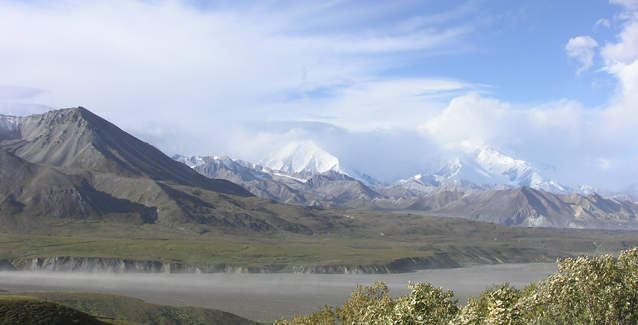
Air Quality Monitoring
Continuous air quality monitoring has been conducted in the park since 1980 at a station near Park Headquarters. Sampling occurs through several nationwide air quality monitoring networks, which measure atmospheric deposition, ground-level ozone, sulfur and nitrogen oxides, fine particles, visibility, and associated meteorological parameters. A second station in Trapper Creek, established in 2001, also measures fine particles and visibility through the nationwide IMPROVE monitoring network (Interagency Monitoring of Protected Visual Environments).
While Denali has some of the cleanest air measured in the United States, small amounts of industrial and agricultural contaminants from other continents make their way into the park each year in a recurring seasonal pattern. The peak concentrations of international contaminants generally occur in the late winter and spring. Local and regional emissions are also measured in the park in small quantities each year. During summer, naturally-occurring wildfire smoke is the primary contributor to air quality degradation.
Visibility Webcam
The Denali visibility webcam is part of a nationwide network operated by the NPS Air Resources Division. During summer, the camera takes a picture of the Alaska Range once every 15 minutes, and the image is transmitted to the web via satellite. The webcam home page also displays current ozone and weather data from the air quality monitoring station near Park Headquarters. All images are archived throughout the summer for a long-term visual record of visibility, one of the air quality related values (AQRVs) protected under the Clean Air Act.
Mercury Monitoring
Mercury is a global contaminant that is transported into Denali in very low concentrations, but has the capacity to bioaccumulate (become more concentrated) as it reaches higher trophic levels in the food web. In spring 2014, researchers installed a mercury analyzer at the park air quality monitoring station. The analyzer measures gaseous elemental mercury (GEM), and is part of the nationwide Atmospheric Mercury Network (AMNet).
In a separate mercury monitoring project, citizen scientists began collecting dragonfly larvae in 2012 as bioindicators of mercury in the environment. Dragonfly larvae prey on insects and small fish, and they can live for several years before emerging as adults. This allows mercury to accumulate in their tissues over time. Dragonfly larvae collected from Denali in 2012 and 2013 contained relatively low amounts of mercury in comparison to most other parks sampled that year. This project will continue in 2015.
More Information
Last updated: February 24, 2017
